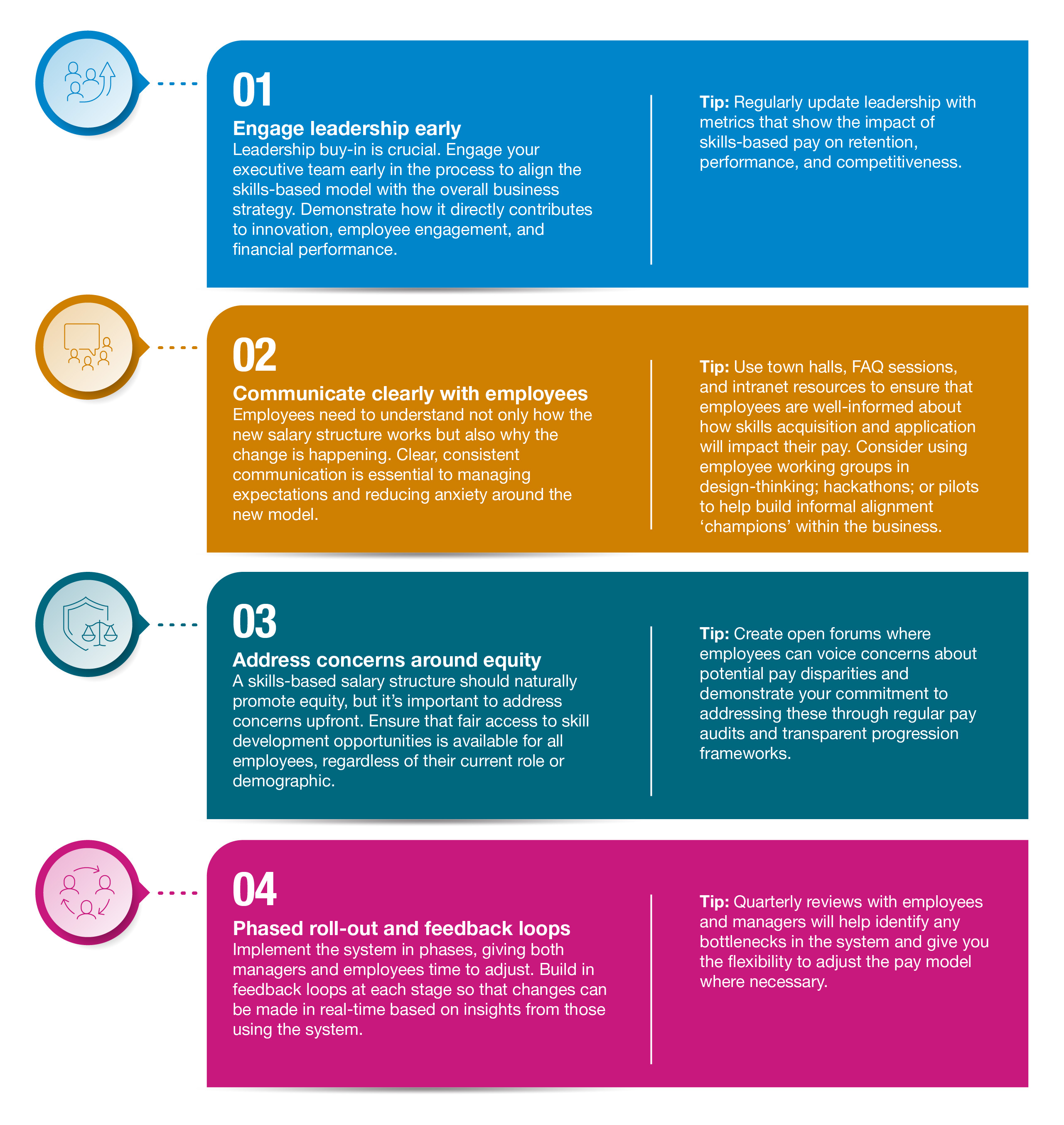Mastering the new pay model: Transforming salary structures for skills-based organisations
Raise your hand if the conventional model of linking pay to roles, job size, or seniority is proving inadequate in addressing the demands of a skills-based economy in your business? If the answer is yes, this paper is for you!
As digitalisation, automation, and globalisation redefine industries, the speed at which new skills emerge - and older ones become obsolete - has never been faster. Relying on fixed job descriptions and standardised salary bands typically results in pay practices that are slow to respond to these shifts. We are seeing increasingly that the question is no longer whether organisations should adopt a skills-based reward model, but how quickly can they make the transition?
While we recognise that skills-based pay can take many forms and capture different elements of reward, this paper focuses on key considerations for the development of a skills-based salary framework. Salary structures, a critical component of a holistic skills-based pay framework, must be designed to support performance, innovation, and equity. To stay competitive, these structures need to evolve in line with the growing demand for skills, promote fairness and transparency, and align with broader strategic goals. Today’s workforce expects reward to reflect their evolving expertise and contributions, not just their position. The lack of agility in traditional pay models can lead to:
- Stagnation: Talented employees may feel undervalued if their reward doesn’t reflect the new, high-demand skills they’ve acquired.
- Inequities: Gender or ethnicity-related pay gaps may become embedded in systems that reward tenure over actual value.
- Lack of internal mobility: Employees are less likely to explore lateral or growth opportunities if there’s no clear financial reward for developing cross-functional or strategic skills.

The case for skills-based salary structures
A skills-based salary structure transforms the way organisations think about reward. Instead of rigidly assigning pay based on job titles or a static view of job size, this model ties salary positioning and progression to the acquisition, application, and mastery of skills that are directly aligned with business needs. It enables organisations to reward continuous learning, innovation, and agility - key attributes that drive performance in today’s economy.
But why is this shift essential?

Building a skills architecture aligned with business needs
The cornerstone of a skills-based salary structure is a well-defined and dynamic skills architecture. This architecture outlines the critical skills most valuable to your organisation that drive business performance, categorises them based on level of complexity, scarcity, and strategic importance (‘impact’), and defines the framework for linking these skills to reward outcomes.
This process begins by identifying core competencies and emerging skills that align with your business strategy. Once these competencies are established, creating standardised criteria for measuring skill acquisition, application, and mastery is essential. This ensures consistency in how skills are evaluated across the organisation.
A practical way to organise this process is by mapping out skill categories that will form the backbone of your reward system. These categories help differentiate between the various skills required across levels and functions, allowing you to tie reward directly to the most relevant competencies. For most organisations, skills can be broadly grouped into three key categories:

To be effective, this skills architecture must remain dynamic, evolving as new business strategies and market trends emerge. To stay competitive, organisations need to continuously review and update the skills they value most, ensuring their workforce remains adaptable and future-ready.

By mapping skills in this way, the organisation can ensure its reward system is comprehensive, scalable, and responsive to future needs.
For employees, one of the key advantages of a skills-based pay model is the clarity it provides around career progression. Employees can see a clear path forward by understanding the specific skills required to move up the pay structure. This transparency helps reduce uncertainty, enabling employees to focus on acquiring the skills that matter most to their development and career trajectory within the organisation.
Designing multi-tiered pay bands
One of the key complexities in designing a skills-based salary structure lies in determining what exactly should be rewarded. Many organisations embarking on this journey may overlook the nuances between different stages of skill development, namely: acquisition, application, and mastery. In our view, these distinctions are crucial for creating a scalable and fair pay model that encourages continuous learning, effective skill application, and long-term expertise. It would also encourage consideration of multi-tiered pay bands that link salary progression to three distinct stages of skill development as a viable route:

To clarify how these three stages fit into a successful skills-based pay framework, let’s break down their strengths, potential downsides, and best practices for rewarding each:

Under this model, salary bands and pay progression should differentiate clearly between skill acquisition, application, and mastery. This ensures that employees understand the trajectory of their reward, promoting transparency and engagement. Some simple examples are outlined below:

Leveraging advanced analytics for fairness and transparency
Advanced analytics can play a powerful role in enabling a skills-based salary structure work effectively. Data-driven insights ensure that reward decisions are equitable, transparent, and aligned with measurable outcomes. Here’s how analytics can help:
- Monitor pay progression: Analytics tools can track employee progression through skill tiers, forecasting when salary adjustments are necessary and ensuring pay remains fair across all demographics.
- Forecast skills gaps: Predictive analytics can highlight future skills shortages, allowing organisations to proactively invest in learning and development to address these gaps.
- Ensure equity: Machine learning algorithms can be used to audit pay practices and eliminate unconscious bias, ensuring that salary progression is based solely on skills and contributions, not demographic factors.
By integrating real-time dashboards, organisations can ensure that reward practices are data-driven, fair, and aligned with business goals.

Simplified strategies for early-stage adoption
For organisations just starting their journey toward skills-based pay, it can be daunting to implement advanced analytics and data-driven tools. Here are four simpler, non-technical strategies to get started:

Achieving pay transparency and embedding EPTD compliance into a skills-based pay model
In light of the European Pay Transparency Directive (EPTD), organisations must do more than simply embrace the advantages of skills-based pay. To ensure full compliance, it is critical to embed EPTD-aligned foundations into every aspect of the pay model, from how salaries are structured to how pay progression is communicated and monitored. The Directive’s aim is to eliminate pay discrimination and increase transparency by requiring organisations to provide clear, objective evidence on how pay decisions are made and how they ensure equity across gender and other demographics.

Managing the cultural shift: Effective change management
Implementing a skills-based salary structure is more than just a technical shift; it is a cultural and operational transformation. Successful adoption requires thoughtful change management and strategic engagement with all stakeholders.

Conclusion: Leading the skills-based pay transformation
Adopting skills-based salary structures offers more than just a shift in how organisations reward employees; it’s an opportunity to fundamentally reshape your talent strategy and enhance employee engagement, innovation, and fairness.

A key strength of this model lies in its ability to empower employees by giving them greater control over their own career development. With clear, skill-based criteria for progression, employees can actively pursue growth in areas that align with both personal aspirations and organisational success. This autonomy fosters not only personal fulfilment but also deeper engagement and loyalty.
However, effective transformation requires strategic alignment, the integration of advanced analytics, and a strong commitment to fairness. By embedding transparency into your reward model, backed by data-driven insights, you ensure that both organisational and regulatory requirements, such as those outlined in the European Pay Transparency Directive, are met while maintaining equity across all levels.
For those ready to embrace this shift, the rewards are immense: stronger talent pipelines, a more engaged workforce, greater equity, and the ability to thrive in a skills-based economy. Skills-based pay is re-shaping the future of reward. How will your organisation embrace this transformation?
If this thought-piece resonates with any of the challenges and opportunities you're facing, let’s connect to explore how a skills-based salary structure can transform your organisation.




